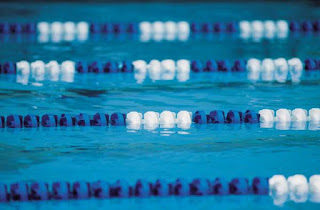
Since I’m an enthusiastic swimmer, and since the summer London Olympic Games are rapidly approaching, I got to wondering which woman holds the fastest Olympic record in the 100 meter freestyle stroke.
I discovered the current Olympic record in the women's 100 meter freestyle swimming event is held by Britta Steffen of Germany with a time of 53.12 seconds. The record was set at the 2008 Beijing Olympic Games.
But really, how fast is that? To help me figure this out, all it took was knowing some simple mathematics!! It helps to keep in mind the following:
• 1 meter = .001 kilometer = 0.000621 miles = 0 miles and 1.09 yards
• 1 hour = 3600 seconds
Now we’re all set to go:
• The swimming pool is 50m long, 25m wide and 3m deep.
• It takes 1 complete lap to swim 100 meters.
• 100 meters = 0.10 kilometers = 0.062 miles.
• Speed = distance divided by time in hours; so time in hours = 53.12 seconds ÷ 3600 seconds = 0.014755 hours.
So, Steffen’s speed = 0.062 miles ÷ 0.014755 hours = 4.2 miles per hour!!! Yikes! Steffen’s speed is amazing when you realize that the average time it takes a strong swimmer to swim freestyle in a pool for one mile is around 20 minutes -- which is approximately 3 miles per hour!!! Wow!
Jeanne Lazzarini, RAFT Math Education Activity Developer
Comments
Post a Comment